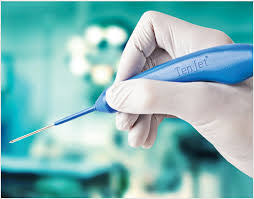Tendon pain can be a stubborn and frustrating experience, especially when rest, stretching, and even injections don’t seem to help. That’s where advanced procedures like TenJet come in. Whether you’re a patient looking for answers or a physical therapy provider working with post-procedural clients, understanding what TenJet is—and how rehab supports healing—is key to better outcomes.
What Is the TenJet Procedure?
The TenJet procedure is a minimally invasive, ultrasound-guided treatment used to remove damaged tissue from tendons. It’s most commonly used to treat chronic tendinopathies like:
- Lateral epicondylitis (tennis elbow)
- Patellar tendinopathy (jumper’s knee)
- Plantar fasciitis
- Achilles tendinopathy
- Rotator cuff tendinosis
Here’s how it works:
- A small device (TenJet) is inserted through a tiny incision under ultrasound guidance.
- The tip of the device emits a high-pressure stream of saline and suction, which breaks up and removes degenerated tendon tissue (called “tendinosis”) while sparing healthy tissue.
- There are no stitches, and the procedure typically takes less than 20 minutes.
It’s essentially a targeted cleaning and removal of non-healing tendon tissue, allowing the body to kickstart a new, more effective healing process.
Why Is TenJet Needed?
Chronic tendinopathies are often degenerative rather than inflammatory. Over time, repetitive stress can cause the tendon’s collagen fibers to break down, leading to thickened, disorganized, and poorly vascularized tissue that doesn’t heal on its own.
Conservative treatments like rest, NSAIDs, physical therapy, and injections can help many people. But for some, especially those with long-standing pain, these approaches may fall short. TenJet offers a middle ground between conservative care and surgery. Please note that this procedure is not appropriate for everyone. Seek medical advise from a licensed professional.
How Physical Therapy Supports Recovery After TenJet
Post-TenJet rehab is essential. Removing the degenerated tissue is just the beginning—how the tendon is loaded, strengthened, and retrained afterward determines long-term success.
Here’s how physical therapy helps after TenJet: (This is an example of guidelines, not a protocol. Always follow specific physician’s orders and protocols)
1. Protect the Healing Tissue (Weeks 0–2)
- Patients are often instructed to avoid aggressive loading a specified number of days post-procedure.
- PT focuses on gentle range of motion, reducing swelling, and preventing compensatory movement patterns.
2. Restore Normal Movement (Weeks 2–4)
- Gradual reintroduction of isometric and light isotonic exercises under therapist supervision.
- Address biomechanical faults that may have contributed to the tendinopathy (e.g., poor scapular control, faulty foot mechanics, kinetic chain imbalances).
- Begin light manual therapy and neuromuscular re-education.
3. Rebuild Tendon Load Tolerance (Weeks 4–8)
- Progressive loading with eccentric and concentric strengthening tailored to the specific tendon treated.
- Tendon loading principles (such as slow, controlled tempo, and avoiding pain >3/10 during or after exercises) guide progression.
- Plyometric preparation for athletic patients may begin in later stages.
4. Return to Function and Sport (Weeks 8–12+)
- Task-specific and sport-specific retraining.
- Preventative strategies to reduce reinjury risk (ergonomics, cross-training, flexibility, warm-up routines).
- Patient education remains critical—tendinopathy is often multifactorial, and long-term success includes understanding load management and early symptom recognition.
Key Takeaways for Patients and Providers
- TenJet may be an effective option for patients with chronic tendinopathy who haven’t improved with conservative care.
- Physical therapy after the procedure is crucial for restoring function, preventing recurrence, and achieving the best outcomes.
- Collaboration between the interventional physician, physical therapist, and patient ensures a personalized recovery plan that supports tendon healing and long-term performance.
If you’re a patient recovering from TenJet or a clinician working with post-procedural cases, don’t underestimate the power of skilled physical therapy in promoting full recovery. The right movement at the right time makes all the difference.


